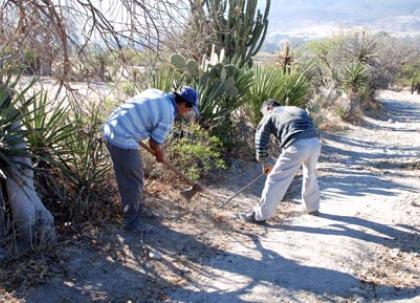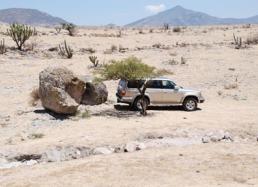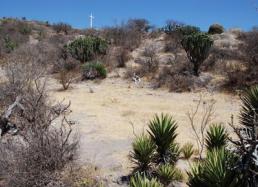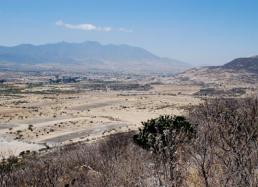3: Preparation for a New Site
During a long, four-day drive, when we weren't dissecting the route through central Mexico, there was plenty of time for Linda and me to contemplate and discuss all the things that we needed to do when we reached Mitla on a warm, late Thursday afternoon. There was much to ponder as the prospect of beginning excavations at a new site is both enormously exciting and downright challenging.
The excitement is amplified by the fact that the Mitla Fortress is a prehispanic marvel that has been in the archaeological literature for roughly a century and a half, but has never seen significant prior excavations. The challenge is enhanced by its rugged hilltop setting kilometers from the town of Mitla.
Fortunately, for more than the past decade, we have used Mitla as our base of operations (even when our fieldwork was elsewhere). And this year, that continuity was a huge asset, as we could rely on the same families for our housing needs, hire our same cook (Doña Elena), and start with the assistance of two local men from Mitla (Rolando and Juan), who each have worked with us for more than five years.
In one of the houses that we rent, we also have our temporary lab, which doubles as a storeroom when we're not in Mitla. I cannot stress how important this foundational web of relationships and infrastructure was for starting out the 2009 season, since moving sites also means hiring and training a basically new field crew, finding a new night guardian, and dealing with a set of novel logistical challenges.
Arriving Thursday afternoon, there also was little time to rest, as we had already made a Friday morning appointment with the Director of the Oaxaca Center of the Institute of Anthropology and History in Oaxaca City. Yet in preparation for that meeting, we still had to arrange to take occupancy of our house and lab, unload our car, and begin the process of setting up our three-month residence (at least to the stage that we could find what we needed to be comfortable and efficient going into Oaxaca.)
Over the next week, as one-by-one we met the responsibilities and challenges necessary to begin fieldwork, we were so aware and appreciative that conducting archaeology in a non-native land is so much a process of building personal relationships—not only with the professional/archaeological community, but also with the people who are your co-workers and neighbors.
We relied on the long-standing and cordial ties that we had with the three families that we rent houses from, the Director of the Oaxaca Center, Juan and Rolando, Elena, and the Municipal President of Mitla to receive the permissions that were required from the Center, as well as the municipality of Mitla and the communal landholding organization of Mitla (the Fortress sits on communal land) in order to rent three houses, to line up a crew of 15 people, and to find a young man (Julio Cesar) who was willing to spend nights as the guard at the site.
Once these essential matters were arranged, we then began contemplating how we would get to the site, which terrace we would select to excavate, and what preparations were needed to begin the excavations. Early in the week, we concentrated on removing spiny vegetation from both a narrow, dirt-and-rock road that gets us about half the way from the edge of Mitla to the base of the Fortress (see above photo.) And then we cleared some abandoned fields that we traverse so that we can park at the foot of this rocky hill (see Photo #1 below.)
Later, we walked over the site, opting to begin excavations on Terrace 56, and to clear some of the vegetation on the selected terrace (as well as areas around the excavation site where we'll situate the watchman’s tent and piles of excavated dirt and rock). Terrace 56 is situated below the famous stone walls of the Mitla site, as well as a modern shrine or capilla (see Photo #2 below.)
By Friday, we also used the laser transit to place a systematic grid system on the terrace, which serves to define the units in which we plan to excavate. For clearing and for laying out the grid, we were able to contract about half the new Mitla crew (a crew diverse in sex and age) to help us, and that speeded up the pre-excavation preparation process.
By Saturday, we were ready to take another trip into Oaxaca City to pick up the first members of our North American crew to arrive: Lacey, who will assist in the field and the lab, and Tasha, who will intern as our illustrator in the lab. With their arrival by plane, we're ready for Monday so that by the time that we've been in Mitla a bit over a week, we think we'll be poised to start excavations.
World of the Day: velador, which means “watchman.” The second word of the day is cocinera or “cook.” Our project could not function effectively without these two critical positions and the people who fill them.
More soon,
Gary






